A 3-step extended guide for charities to roll out effective end-of-year appeals. | Message, design and advertise your holiday fundraising appeal for maximum impact.
Wait, whaaaat? It’s end-of-year soon?
...wasn’t it just January?
That’s right. Ready or not (and no one’s ever really ready) Christmas is upon us. The supermarkets are stocked, you’re wracking your brains for present inspo and friends want to “catch up before Christmas”.
Basically, there's a whole lotta stuff going on!
The festive period can really boost a charity’s donations. Whether the spirit of giving kicks in or people decide to gift a donation to friends or family, it’s often a time to dig deep.
And, for our friends in the USA and Canada, Christmas coincides with their end of financial year. This ups the ante even more, as people scramble to make their last-minute contributions.
So. Let's assume your communities are poised and ready to give...
How do you message, design and advertise a kick-ass end of year appeal?
We spoke to our resident and industry experts across messaging, design and advertising in a recent masterclass:
➡️ Michaela Del Casale - Digital Engagement Specialist, Black Dog Institute
➡️ Luke Meyrick - Lead Designer, Raisely
➡️ Garth Stirling - Head of Digital Services, ntegrity
Then, we pulled out the best bits and created this handy Guide. It’s packed with tips and tricks for end of year appeal strategies to help you end the year on a high.
How to message your appeal?
If you’re rolling out a year-end giving appeal, then guess what? So are countless other charities.
You need clear, concise communication pieces that actually ‘speak’ to people. Busy people who are being asked to do things all. The. Time.
(Like you don’t get that. You’re already thinking about your campaigns for next year!)
Let us break down the details for you - there’s no time to lose!
Understand your audience
Always keep your supporters top of mind. Whether you’re creating emails, social media content or ads, know who you’re talking to.
WIIFM (What’s In It For Me?). Everyone wants to know.
By tapping into your audience, you’ll convincingly answer that.
Their prize? Ownership of your organisation’s mission and a chance to make a difference.
Know your ‘why’
This isn’t the time for vague requests. Be crystal clear about what you’re trying to achieve before you ask for anything. Get a solid grasp of your goals and reflect it in every aspect of your messaging.
Stay true to your brand and values
Your brand guidelines are there for a reason. Stick to them!
Ensure your tone of voice, your language and your messages all neatly tie back to your organisation’s look, feel and values.
When your core values come through, you connect to the right supporters. Use every opportunity to weave them into your communications.
Your fundraising community will feel part of your journey and be far more likely to jump on board your campaign.
Take the guesswork out
Again, be clear and concise. Don’t make your supporters guess what you’re asking for (that’s not a particularly fun game).
Go back to high school science and think about cause and effect.
Cause
This is the problem you’re trying to solve together.
Effect
This is how the reader can contribute to a resolution.
It really is that simple!
Stories matter
People are inherently interested in the lives of others. Tell their stories to bring facts and figures to life.
It’s not about guilt tripping them into action or trying to make them feel bad; rather using real life examples to foster empathy and drive change.
When something evokes emotions, people are instantly more engaged. And that encourages them to get involved and be part of the solution.
In it together
Throughout your campaign, really think about the relationship you’re trying to build with your community. Focus on the ‘we’ - not of your organisation (no, no, no), but as in you and your supporters. Working as a team to reach a common goal.
At the risk of sounding like a broken record, supporters need to:
- Trust the brand
- Feel connected to the cause
- Know they’re part of something worthwhile
Vertical vs horizontal talk
Vertical communication is talking ‘down’ to your audience. Like your organisation is the top dog and your supporters are somewhere, well, beneath you.
It’s messaging like “we have a solution and we need your money.”
Yeah, thanks, but..no thanks.
Horizontal communication focuses on bringing your supporters into the fold and making them part of the process. It’s way more inclusive and empowering.
Your messaging might be along the lines of “with your help, we can achieve this together.”
Much less demanding and much more effective.
Offer other ways to get involved
Donating isn’t always possible for some people. They still want to contribute to the cause, though.
Give them some different (no less valuable) avenues to contribute to your year end giving. For example:
- Sharing your message
- Volunteering with your organisation
- Organising a fundraiser
Bring your community together
Think about ways to create a sense of camaraderie within your fundraising community.
Quote your supporters on why they’re involved with your organisation. Draw on testimonials and case studies explaining how your cause has changed peoples’ lives.
Keep the conversation flowing on social media. Passionate supporters are often vocal on these channels - ensure you respond to comments and make it a live, happening forum.
It’ll show you care about your community and want to stay connected.
🔥 Lastly, some hot tips
📧 The power of emails
Peoples’ inboxes are bulging with unread emails. When someone does open one, they’ll spend, on average, 11 seconds reading it. That gives you approximately half that time to grab the reader’s attention.
Your language, format and structure has to be top-notch. Easy to read, informative and good-looking.
☝️ Only ask for one thing
Choice isn’t always good! Limit your ‘ask’ to one thing.
When people have too many options, it might get all too hard. Then what? They don’t choose anything! And your lovely email goes to waste.
🔓 Subject lines make a difference
Yes, we’re still on emails (they matter). And what’s the first thing people see when an email pops into their inbox? The subject line.
There’s no hard and fast rule about length, but do try for the Three Cs:
- Clear
- Concise
- Compelling
The best subject lines inspire action.
🎯 Be specific
Again, tone down the choice here.
When you ask for an actual dollar amount (rather than a vague ‘donate here’ request), you’ve got a better chance of getting it.
🧹 Keep your house in order
It’s worth taking the time to clean up your database. People who haven’t engaged with your organisation since the new millennium probably aren’t going to start now.
That said, be mindful about bombarding your active supporters. No one likes receiving multiple requests for money, least of all from an organisation they respect and believe in.
This leads us to tracking campaigns and how successful (or not) they’ve been.
Insights into what works and what doesn’t gives you the power to improve your end of year fundraising appeals.
Use your data wisely!
❤️ Head | Heart | Hand
As you plan every appeal, remember this:
People think with their heads, feel with their hearts and give with their hands.
Address each of those in your messaging and you’re halfway there.
Book a demo and we'll show you how to customise your messages, set a trigger and schedule a journey using Raisely's automation tools.
Ready to create your
next campaign?
Designing your campaign
Your campaign is coming together. You know what you want to say, how you’ll say it and who you’re targeting.
Now it’s time to bring in the right design elements to really make it pop.
Design 101 + best practices
You might not be a designer, but you know what looks good.
Use these 3 simple tricks to pluck your campaign right out from the crowd.
Hierarchy
Depending on the layout, your eye is drawn to different things.
Ensure the most important parts (for example the ‘donate now’ button) are at the top of the chain, so to speak.
In other words, establish a logical flow of content that makes sense to the reader.
Much like this blog article, design uses headings, subheadings and paragraphs to help audiences digest the content.
You can adjust your font and button settings in your Raisely campaign to get your hierarchy looking just right.
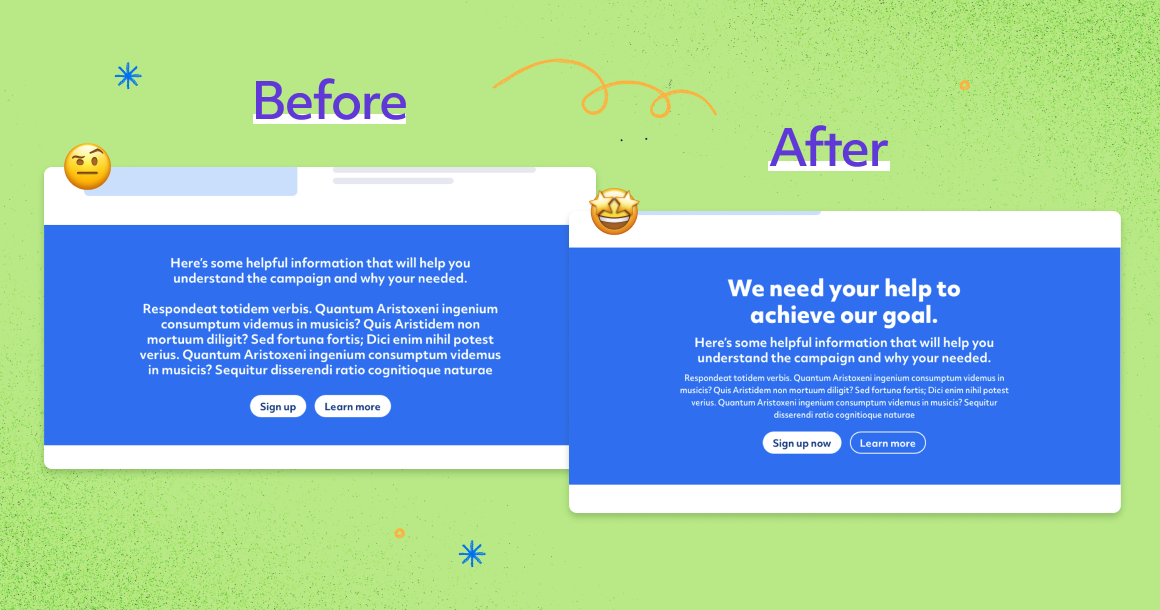
Spacing
We might not live uncluttered, calm lives - but we certainly enjoy looking at them on Pinterest!
Bring that sense of space to your appeal’s design and make it an enjoyable, peaceful experience for users.
Don’t try and cram too much in - it becomes overwhelming and inaccessible.
Speaking of which 👇🏼👇🏼

Accessibility
With 1 in 6 Australians living with a disability, accessibility is simply non-negotiable.
Ensure your year end giving appeal is inclusive and visible to everyone. It could be as simple as changing colours to make text stand out.
Just remember: even if you can see and understand something, it doesn’t mean everyone will.
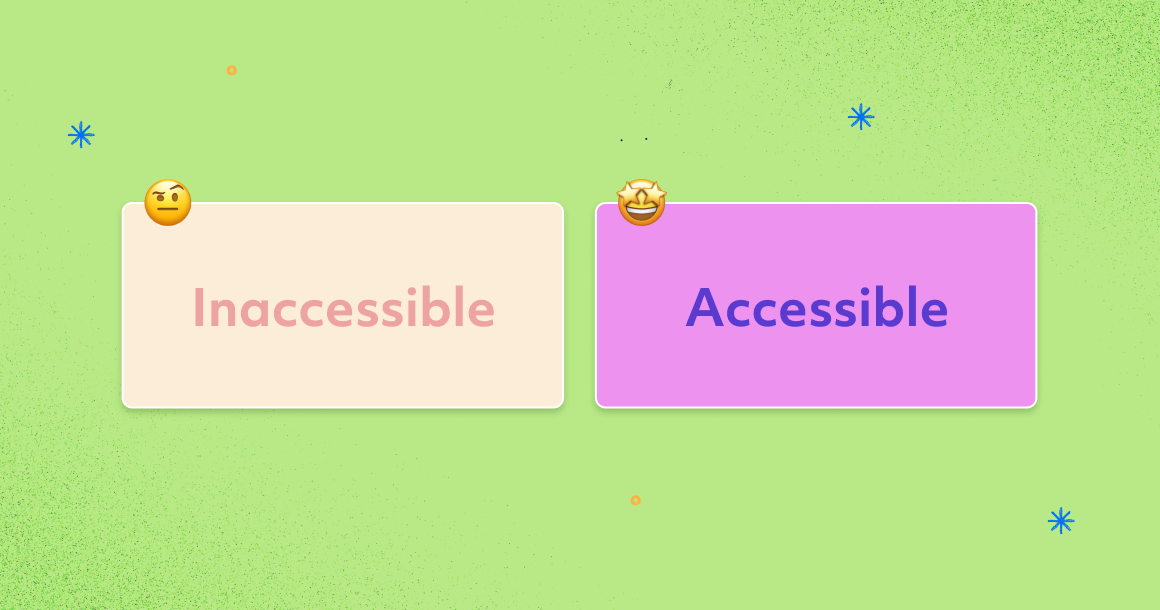
How to build and structure your appeal page
There are countless ways to put together your appeal page.
To keep things simple, we’ve covered short form and long form here.
But, there are no strict rules!
Take the ingredients that work for you and mix them up to create your unique page.
Short form structure
You might choose this structure if you're short on resources or time.
Or, perhaps you’ve already pumped out lots of information to your community and they don’t need the whole nine yards.
Either way, it’s a perfect way to tell your story concisely.
A short-form structure looks something like this.
🗣 A clear, key message to directly promote what you’re talking about
👀 An eye-catching image to conjure up emotions and seal the deal
📈 Supporting messaging and progress bar / social proof highlighting the common goal fundraisers are working towards
ℹ️ Some short supplementary information about the appeal (but not distracting from the main message)
💰 Donation form / handle giving supporters a clear idea of what their money is doing
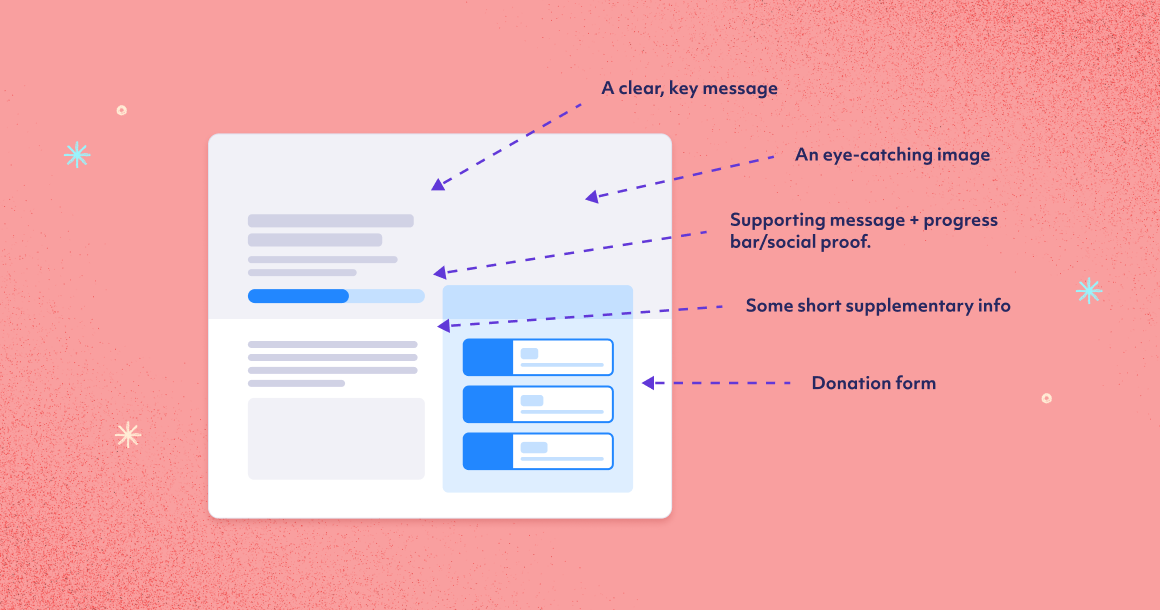
Long-form structure
Got the time to take your donors on a longer journey? Try a long-form approach.
When supporters can drill down into the details, they better understand your cause. And when they understand more, they’re likely to beef up their donations and share with their networks.
Your long-form structure could look a little like:
🏁 Intro with a donate button
This provides a clear CTA for supporters to quickly jump to the donation form. If that doesn’t take their fancy, it’s onto the next step 👇🏼
📚 Social proof
A bit like a good book or movie review, this gets people excited about donating. They see why and how others have contributed and it spurs them along.
📊 Stats
A clean, bite-sized statistic can really resonate with people. They’re shareable and they provide a clear reason to donate.
💵 Donate button
Obviously, it’s your main CTA so it’s gotta be front and centre. We don’t want people wandering away!
💥 Impact / About / Background is for people who still need extra reasons to donate. Reinforcing the impact your organisation has can often be the turning point for donors teetering on the edge of giving.
🎬 CTA
Yet another chance to send users right back to the donation form where (fingers crossed) you get them over the line.
⚠️ Risk reduction
Another chance to quell fears and reassure donors that their money and time is in safe hands. Answer questions before they’re asked and ease potential concerns.
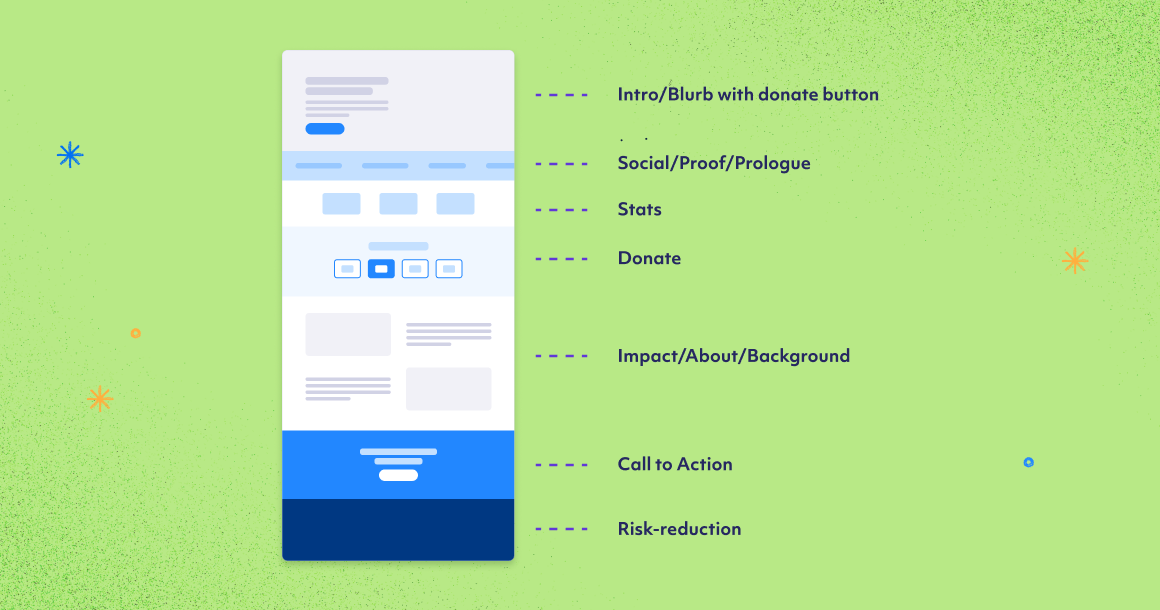
How festive do you go in your design?
Introducing a touch of festivity won’t ruin your design. It’s actually kinda cheery!
If you’ve never had a chance to use the Raisely Campaign CSS Editor, check it out here.
It helps you change the look and format of your web pages and user interfaces. Whether you want to stick to Raisely’s designs or import your own stylesheets, the process is quick and straightforward.
Racing towards the holidays and got no time? No worries.
Raisely has done the hard work for you and can guide you through some cute Christmas mixins here.
🎅🏼 Have fun with some snow and Santa hats! 🌨
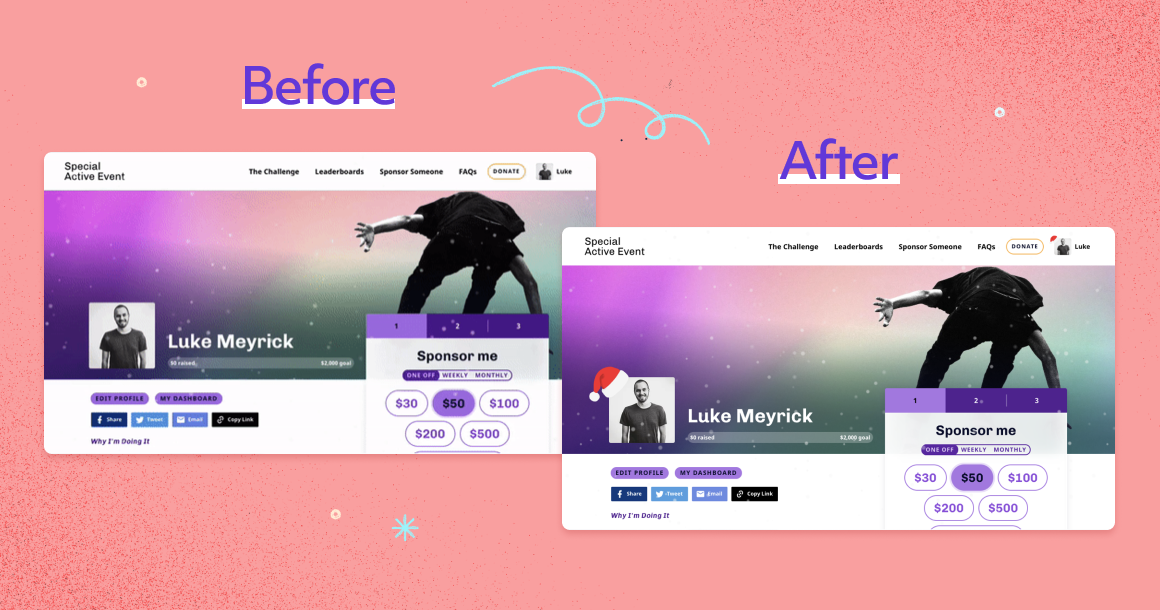
Need some help applying some these design tricks? No problem. Book a demo and we'll give you a hand so your campaign is nice and sparkly in no time!
Ready to create your
next campaign?
Promoting your year end appeal
It’s all coming together very nicely. Now what?
You need eyeballs 👀 in front of your campaign.
Let’s walk through current trends and how you can maximise your donations by homing in on the right audiences and channels.
Current advertising trends worldwide
You won’t be surprised to know that by and large digital has come of age across most demographics.
Consumers in every age group are turning to online research to determine what charities to support.
- In just 8 weeks, digital adoption rates vaulted to a level predicted 5 years from now
- 45 + year olds are driving the growth in online research
- 43 per cent of over 65s now online shop (up from 16 per cent)
So what does this mean for you?
It means there’s never been a better time to roll out an online end of year fundraising appeal.
People in every community have witnessed NFPs spring into action to provide emergency support to those in need. And that’s been a big, old reminder to everyone just how critical charities are - not only during crises, but anytime.
In fact, 85 per cent of Australians say the pandemic has made them appreciate the role of charities more. While 90 per cent feel proud of how NFPs have rallied during this time.
I want some more cold, hard stats
Coming right up (we love stats, too).
🇦🇺 Australia
- 1.3 million households shopped online for the first time last Christmas
- This new way of purchasing flows to online giving, with 80 percent saying they’d support online giving this year.
🇺🇸USA / Canada 🇨🇦
- 44 percent growth in US e-commerce in Q4 2020
- 63 percent of US / Canadian donors now prefer to donate online
- 40 percent gave through Facebook tools. Of those, 88 per cent said they’d use those tools again
🇪🇺 Europe
- A whopping 81 percent in digital adoption in 2020
- Meaning 95 percent of the region now turns to the Internet in their everyday lives
- 60 percent of Europeans donated online during COVID-19
How to maximise year end giving donations
It’s clear the spectacular shift towards online has also flowed into charitable giving.
So, how can you ensure your organisation harnesses this situation?
It all boils down to two main elements:
- Reaching the highest performing digital audiences
- Choosing the channels with high ROI
Reaching the highest performing digital audiences
Want to know the biggest mistake organisations make when they’re targeting digital audiences?
They go too broad. In other words, they try to be everything to everyone.
Our advice? Start with the highest performing audiences and work outwards from there. That’ll give you the best bang for your buck.
Dig out your:
📝 Email lists
📝 Donor lists
📝 Lapsed donor lists
📝 Lead lists
Upload them on to Facebook or Google Ad Manager, see who your biggest supporters are and go from there.
Divvy them up into high ROI, medium ROI and low ROI.
High ROI audiences
High ROI supporters:
- Are active donors
- Have donated previously
- Already know you
Best bet for reaching high ROI audiences
- Retarget previous visits
- Use brand keywords (‘cos they know you)
Medium ROI audiences
Moving on to medium ROI audiences, who:
- Might be lookalike audiences
- Could also be lapsed donors
Best bet for reaching medium ROI audiences
- Use specific creative to target them
- Video reviews can work wonders across social media and other channels (for broad brand and campaign awareness)
- Use core keywords
Low ROI audiences
As for your low ROI supporters, they:
- Are a broader affinity segment
- Offer an opportunity for prospecting
Best bet for reaching low ROI audiences
- Look for crosses and overlaps in audience lists
- Use broader keywords (to increase your traffic)
Choose the channels with high ROI
So, what are the best advertising channels?
Let’s first look at the channels that most inspire giving (they are fairly consistent across regions):
- Email (most popular)
- Social media
- Website
- TV
As we’ve covered off email further up in the Guide, we’ll focus exclusively on social media.
Social media
Almost universally (across countries and age groups), it’s all about Facebook in the social media space.
Facebook holds mass market appeal (yes, younger audiences do look to Instagram and Snapchat, but are still very much tuned into Facebook).
That said, YouTube is coming of age as a source of information.
People turn to YouTube for entertainment and research (think ‘how to’ and ‘what is’ type questions). They’re watching videos to understand things because sometimes it’s more appealing than reading.
And, because it’s owned by Google, it can help with SEO and organic search.
My budget is tiny. Where do I start?
Kick off with Google and Bing paid search. You only pay per click, so it’s a cost effective place to start your year end giving appeal.
NFPs can access up to $US 10,000 each month from Google Grants for advertising. And, while Bing isn’t the first channel that comes to mind, it still brings in around 20 percent of high value donors.
Drive users to your donation landing page to make those clicks pay off.
From there, move into social media to tell your bigger story. This could take the form of:
- Display ads (keep these short and sweet)
- Video (to enhance top of mind awareness)
Finally (where budget allows), try Google ads.
Think of this as the billboard of the Internet. So, your ads should pack a punch (and, of course, have the right brand colours for awareness).
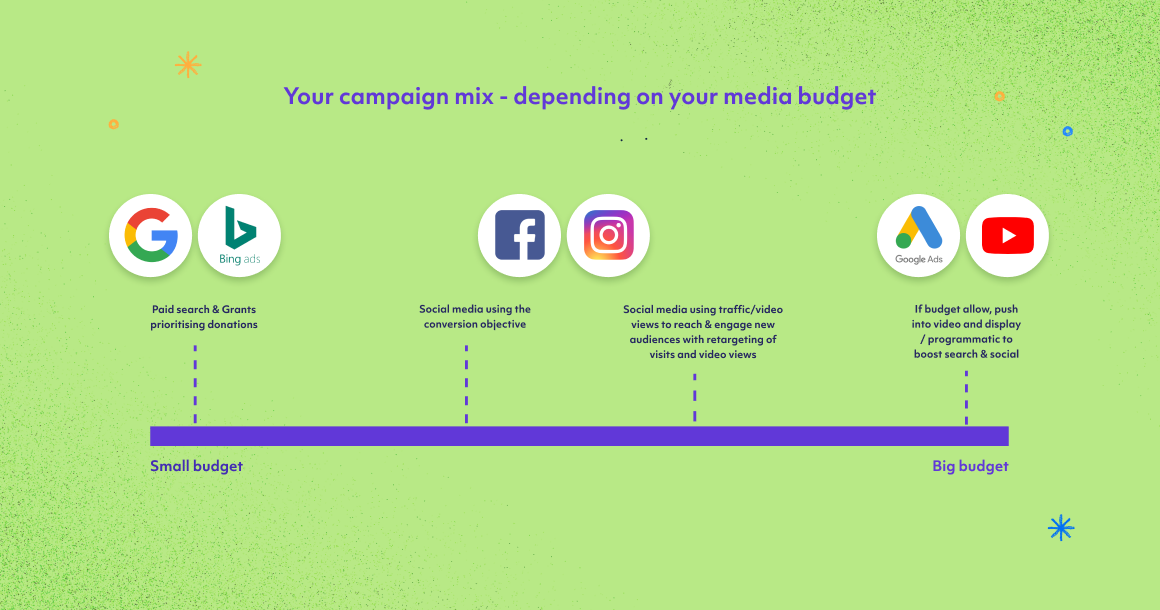
Nothing is set in stone
The beauty of digital advertising is that it’s a flexible beast. You can see what’s working and what’s not and switch things around as needed.
Do your research, start small and have some festive fun!
Start planning your end of year fundraising appeal now!
Get crack(er)ing and book in for a demo today!
Your fundraising community is ready to help you finish the year with a bang.
And so are we.
Ready to create your
next campaign?

Elissa is a Sydney-based copywriter, working as a word nerd/writer for Pencil + Crown. She loves stepping into a client’s world and crafting creative copy to tell their stories.
